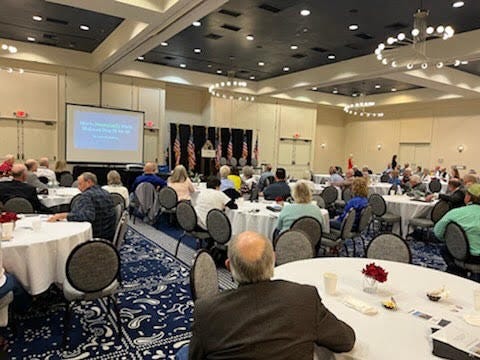Good morning,
For you newbies out there, welcome to Outsider on the Inside. I hope this dispatch from in and around the nation’s capital on underreported topics finds you well.
If you’re just discovering my musings, here’s a backgrounder.
Here’s what I have for you today.
Earth Day Coverage
I dropped a lot of environmental and energy content in recent weeks. If you missed anything, here’s a comprehensive compilation of published links/videos/articles.
Celebrating a More Perfect Environment (Article)
Earth Day: Realistic Ways to Protect Our Environment (VIDEO)
IWF - Earth Day Message (Instagram)
What I Did in Nebraska
I recently checked off my 36th U.S. State: Nebraska.
On Saturday, I returned to Virginia from the Cornhusker State after speaking at the Stop 30-by-30 Summit. The event was hosted by Governor Pete Ricketts (R-NE) and organized by American Stewards of Liberty. I addressed 200 attendees on effective media messaging on the issue.
Critics branded the event as “disinformation” but take it from this attendee and speaker: this Biden policy proposal is not all sunshine and lollipops.
30-by-30, recently rebranded as “America the Beautiful” by the Biden administration, promises to “conserve” 30% of waters and lands by 2030. The administration claims only 12% of lands and 23% of waters (oceans) are protected, respectively. But the U.S. Geological Service (USGS) actually determined 40.6% of federally-owned lands are *already* off-limits to multiple uses.
I’m not a landowner, but as a recreational angler I’m concerned about this initiative’s sweeping proposals, intentionally vague conservation definition, and claims the federal government will “incentivize” land owners to conserve wild spaces. That’s unsettling to me and reminds of California’s Marine Life Protection Act (1999). This law, which claimed to address overfishing, actually harmed the saltwater fishing industry and cut off recreational fishing access to millions of California anglers under the guise of “conservation.”
From the American Sport Fishing Association:
As with most State regulatory actions, there are real economic costs to achieve perceived environmental benefits. In the case of the MLPA, the quantifiable costs are a loss of California jobs, a decline in economic activity and a loss of tax revenues to state and local governments. According to an economic study by Southwick Associates, the potential MLPA designation in Southern California will result in a $150 million loss in sales and will eliminate nearly 1,000 California jobs in that region alone. This impact will occur in the businesses that support the recreational fishing sector. Other areas of the state already being affected by MLPA designations are experiencing similar economic declines; for example, in the first region of the state undertaken by the MLPA – the Central coast – recreational fishing tackle sales have declined by 20% compared to other parts of the state. This early indicator will be followed by lost sales and jobs in the lodging and food industries that support recreational angler visits to central California coastal areas. In the best of times, economic impacts and job losses such as these should never be forced on coastal communities by the State without absolute necessity. Today, in the worst economic climate since the Great Depression, such losses are entirely unacceptable, especially when the program for which they are sacrificed is both unnecessary and, quite possibly, actually destructive to the resources targeted for protection.
In the mid-1990s when the MLPA was first envisioned, California’s ocean environment was in trouble: several fish stocks were in decline, a clear need existed to protect the ocean and its ecosystem and the “green” movement was just beginning to realize its full potential. Along with several other legislative actions, California enacted, but did not fund, the MLPA. In combination, these measures were designed to protect the health of our ocean ecosystem.
The health of California’s fisheries today has improved significantly. The federal government has reenacted and re-enforced the conservation aspects of the Magnuson-Stevens Act (MSA), ending overfishing along the entire Pacific coast. The conservation provisions of the state’s Marine Life Management Act (MLMA) largely have been implemented, and California’s marine fish stocks are rebuilding. Global issues including ocean acidification, ocean side development, invasive species, terrestrial pollution, and global warming represent far greater threats to the health of the ocean than recreational fishing ever has, none of which can be addressed or solved by implementing a network of marine protected areas (MPAs).
…
The MLPA as it currently being implemented bears no resemblance to what the Legislature envisioned upon its passage. A program originally estimated by the Legislature to cost California $250,000 per year is now estimated to cost over $40 million annually to enforce - resources that California simply does not have. Without sufficient enforcement, MPAs have been shown to have neutral or even negative results, as they in effect become Marine Poaching Areas.
The MLPA is having serious negative financial impacts on coastal communities and on California’s $2.2 billion saltwater recreational fishing industry, while attempting to address a fishing crisis that no longer exists. While there are examples of overfishing and declining fish stocks in oceans around the world, such is not the case off the Pacific coast. The fisheries crisis that the MLPA is supposed to solve has been effectively addressed by implementation of traditional fishery management tools. In the waters of California, there is not one marine fish stock currently experiencing overfishing and the few stocks still under stress are rebuilding due to the strict fisheries management and conservation plans established at the federal and state levels over the last 20 years. For example, of the more than 90 groundfish stocks in California waters (which are the most likely to benefit from an MPA), only nine have ever been designated as overfished. Two of those stocks have been rebuilt in the past five years and the remaining seven are all showing improvement under strict rebuilding plans, which include take restrictions, gear restrictions and thousands of square miles of federally-mandated closed areas known as the Cowcod and Rockfish Conservation Areas. In addition to these fishery management measures, prime marine habitat is already federally protected in selected Habitat Areas of Particular Concern and throughout California via a ban on destructive commercial fishing practices such as bottom trawling. Recreational fishing activities have no such negative impacts on marine habitats. California’s traditional marine fisheries management programs are working, and are even cited as examples of “spectacular rebuilding efforts” in a paper in Science Magazine by several noted marine fisheries scientists.
…
MPAs in state waters along California’s coast that restrict fishing opportunities will not solve these problems, nor will these MPAs be an effective tool in mitigating their impact. Designating MPAs in state waters will not cure the ocean of what ails it. Because the MLPA process (funded by private sources with a political agenda) is based on symbolism, not science, and addresses only fishing, it is far from certain that it will ever achieve its conservation objectives. Data-derived science has taken a back seat to private political agendas throughout the MLPA implementation process, creating barriers to quality work and public policy that serves the people.
Like other Biden administration’s policies, this one would upend true conservation efforts as we know it. That’s why I was one of the first writers/journalists to come out against it.
Want to learn more? Here are some helpful resources on 30-by-30:
IWF: ‘America The Beautiful’ Alternative Lays Out Sound Plan To Conserve Natural Resources
Heritage Foundation: Lands and Habitat in the United States: A Reality Check
Joint Letter to President Biden on 30 x 30 Program | 04.21.21
LegalBytes’ YouTube Success
My friend Alyte Mazeika came to me two years ago asking about YouTube.
She wanted to pick my brain about the platform. She noticed I was populating more content there in the early days of the pandemic.
I wasn’t sure I’d be helpful. I didn’t have many top-performing videos until this interview with Governor Kristi Noem, but I offered the best advice a friend could.
Fast forward two years: She’s become a viral “LawTube” sensation with her LegalBytes Media channel.
To those of us who know Alyte, however, her YouTube success isn’t surprising. She’s a hard worker. Savvy, smart, and affable perfectly describe Alyte. And it’s definitely a Lithuanian thing.
Her channel grew a lot during the Kyle Rittenhouse trial. And her talents recently got profiled in Business Insider for her Depp vs. Heard trial broadcasts happening here in Fairfax, VA.
Here’s today’s broadcast if you’re interested in tuning in:
As of this writing, her livestream is being viewed by nearly 20,000 people. And her channel has close to four million views and boasts almost 86K subscribers.
Congrats, Alyte!
Follow Alyte on Facebook, Instagram, Twitter, and of course, her YouTube channel.
Last Week’s Podcast Episodes
Catch up on District of Conservation episodes below.
Thank you for reading! Let me know your thoughts and encourage your friends to subscribe to the newsletter too.
—Gabriella





